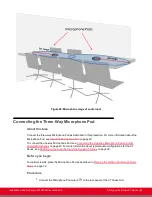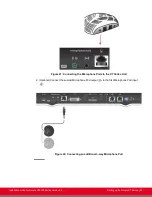
Configuring the TCP or UDP Port Range on the Scopia XT Series
About this task
You can configure the TCP or UDP port range by setting the base port, which is the lower end of the port
range (if, for example, port 3230 is busy).
The Scopia XT Series uses dynamic TCP ports 3230-3248 for the following:
• H.225.0: An H.323 protocol that specifies the messages and procedures used by gatekeepers to
set up calls.
• Q.931:A telephony protocol used for establishing and terminating the connection in H.323 calls.
• H.245: A Control Protocol used for multimedia communication; enables transferring information
about the device capabilities, as well as opening/closing the logical channels that carry media
streams.
• SIP: A signaling protocol used for creating, modifying, or terminating multimedia connections
between two or more participants.
The Scopia XT Series uses dynamic UDP ports 3230-3248 for enabling real-time H.323 and SIP media,
including audio, video, and H.224/data (RTP), and media control (RTCP).
Before you begin
If configuring from the endpoint, you must first enable advanced configuration, as described in
Maintaining the Scopia XT Series Locally from the Endpoint
on page 73.
Procedure
1. Access the port settings as follows:
• From the web interface, select
Administrator Settings > Networks > Preferences >
Dynamic Ports.
• From the endpoint interface, select
Configure > Advanced > Networks >
Preferences > Dynamic Ports
.
Installation Guide for Scopia XT5000 Series Version 3.2
Planning the Topology of the Scopia XT Series Deployment | 30






























